Rookie treasure hunter digs up huge trove of 1,500-year-old pre-Viking gold
A rookie treasure hunter using his new metal detector for the first time has unearthed one of the largest ever hauls of pre-Viking gold.

[Sept 13, 2021: Felix Allen]
The huge treasure trove - including gold medallions as big as saucers - lay hidden for 1,500 years until Ole Ginnerup Schytz found it by "pure luck".
Ole had only been out for a few hours when he heard his gadget beep in a field owned by a former classmate in Vindelev, near Jelling, Denmark.
And after moving a bit of soil, he felt a small piece of bent metal between his fingers.
"It was full of smashes and mud," he told Danish broadcaster TV2.
"I had no idea about it, so the only thing I could think of was that it looked like the lid on a can of sour herring."
But he kept digging and in total 22 precious gold objects were unearthed weighing almost 1kg (2.2lbs).
Archaeologists excavated the surrounding site and discovered the treasure was buried under a longhouse by a clan chief in the sixth century.
Experts say it is one of the largest and most important such finds in Danish history.
But Ole said it was "the epitome of pure luck".
He said: "Denmark is 43,000 square kilometers, and then I happen to choose to put the detector exactly where this find was."
The haul includes medallions called bracteates, beautifully decorated with magic symbols and runes, an early form of writing.
Women would have worn them for protection as people at the time believed gold came from the sun, experts say.
Rookie treasure hunter Ole Ginnerup Schytz had only just bought a metal detector (CREDIT: Vejle Museums)
One large medallion shows the god Odin, which appears to be heavily inspired by similar Roman jewellery that celebrated emperors as gods.
Another shows the fourth century Roman emperor Constantine, famous for spreading Christianity.
They provide invaluable new clues into how Norse mythology arose partly from Roman religion and art, archaeologists say.
VIKING INFANCY
Nearby Jelling is known as the cradle of the great Viking kings who reigned over much of northern Europe from the tenth to twelfth centuries.
But relatively little is known of the period before this in the late Iron Age.
"Here we see Nordic mythology in its infancy," says Peter Vang Petersen of Denmark's National Museum.
"The Scandinavians have always been good at getting ideas from what they saw in foreign countries, and then turning it into something that suits them."
Ole Ginnerup Schytz, who had recently acquired his metal detector, discovered the hoard just a few hours into his search. (CREDIT: Vejle Museums)
Experts believe the treasure was buried by a great chief and showed the area was a centre of power with trade links to the former Roman empire.
"Only one member of society's absolute top has been able to collect a treasure like the one found here," said Mads Ravn, research director of Vejle Museums.
"There was nothing that could make us predict that an unprecedented warlord or great man lived here, long before the kingdom of Denmark arose in the following centuries."
He added: "It is the symbolism represented on these objects that makes them unique, more than the quantity found.
"(They) contain many symbols, some of which are still unknown to us, which will enable us to broaden our knowledge of the men of this period."
Experts believe the gold may have been buried to protect it from invaders, or as an offering to the gods.
It came at a time of huge upheaval after a huge volcanic eruption in Iceland in the year 536 caused climate chaos and famine in Europe.
The Vindelev gold will go on display in Vejle in February before moving to the National Museum.
Ole will be paid compensation under Danish law - although the value of the haul was not revealed.
Many of the most important archaeological finds of recent decades have been unearthed by amateur detectorists.
In January we told how the £2million centrepiece of Henry VIII's crown was found by Kevin Duckett in a field near Market Harborough, Northants.
For more science stories check out our New Discoveries section at The Brighter Side of News.
Note: Materials provided above by the The Brighter Side of News. Content may be edited for style and length.
Like these kind of feel good stories? Get the Brighter Side of News' newsletter.



